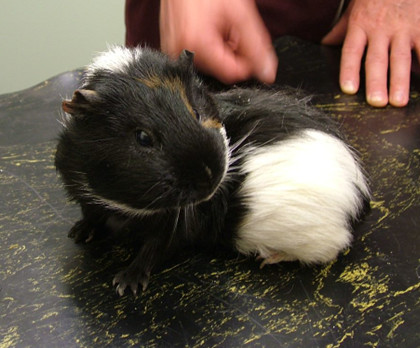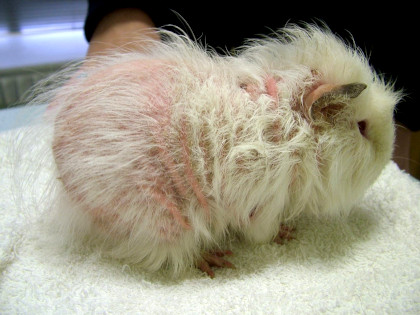Many owners are distressed when they see their guinea pigs scratching, especially if they are breaking their own skin with the nails. Some will even scratch so much that they actually have a seizure. So, what causes guinea pigs to become so itchy?

Ringworm
This is seen occasionally, especially in young guinea pigs who are stressed, malnourished, and/or have an underlying disease. Sores can be usually found on the head and ears, appearing as itchy areas of circular, irregular, or diffuse hair loss, with visible scaling or crusting. Diagnosis is best made by your guinea pig vet, who can then ensure it is treated appropriately.
Ringworm is transmissible to people and other animals.
External parasites
External parasites often found on guinea pigs are fleas, lice, and mites.
- Guinea pigs are commonly infested with the cat flea, especially those sharing a household with dogs and cats. Flea infestation can result in patchy hair loss and itchiness. Adult fleas are tiny (1-2mm) and dark brown and may be seen moving through the fur or on the skin. Using a flea comb to groom your guinea pig will soon tell you if these pests are bothering your guinea pigs as this allows you to check for ‘flea dirt’ (flea poo). You run the fine-toothed flea comb through the fur and tap on a wet tissue. Flea dirt will stain red because it contains blood. Treatment with a safe topical parasiticide is usually effective — ask your guinea pig vet to recommend one.
- Lice irritate and abrade the skin’s surface by biting, and then feed off the bodily fluids that ooze through the superficial wounds they create. Both adult and eggs of lice (nits) are found attached to hair shafts of affected pets. Lice infestations often go unnoticed, but heavy infestations are usually accompanied by excessive itching, scratching, and some hair loss. Scabbing on or around the ears may also be evident. These lice are host-specific and do not present a problem to people or other pets.
- Mite infestations are usually more severe than lice, and more common. Mite infestations on guinea pigs may be inapparent; however, when an infestation does become active (usually associated with stress or malnutrition), the lesions are often first identified in the end part of the body and flanks. This condition is intensely itchy, with hair loss, self-inflicted wounds on the thighs, back, shoulder and neck, and occasionally hyperexcitability and ‘seizures’ associated with intense scratching episodes. Transmission of these mites is thought to occur only through direct contact between infested and non-infested guinea pigs or contact with infested bedding. It can occur at any age, even in pigs that have been separated from other pigs for a considerable amount of time. Most commonly, young guinea pigs are infected by their mother. You will need to visit your guinea pig vet for diagnosis (the mites live in, not on, the skin and cannot be seen with the naked eye) and treatment (pain relief and antibiotics may be needed in addition to a medication that will kill the mites).

References
De Matos R, Kalivoda K (2013) Dermatoses of exotic small mammals. In: Miller W, Griffin C, Campbell K (eds) Muller and Kirk’s Small Animal Dermatology, 7th edition. WB Saunders Co, Philadelphia, PA, pp 1430–1439
Hoppmann E, Barron H (2007) Rodent dermatology. J Exot Pet Med 16:238–255

